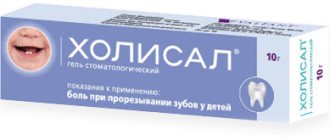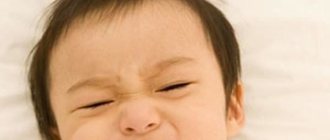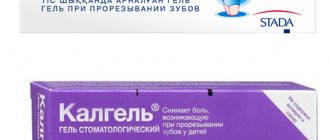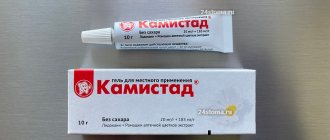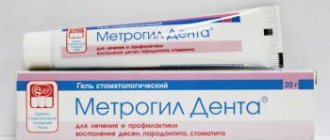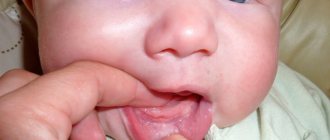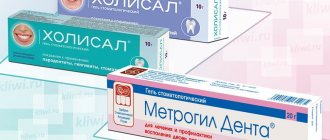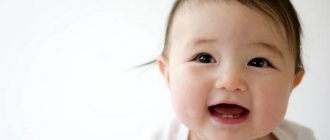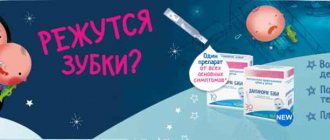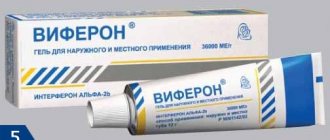From this article you will learn:
- treatment of gums for inflammation - drugs, regimens,
- means for strengthening gums,
- best ointment for teething gums.
The article was written by a dentist with more than 19 years of experience.
In this article, we will conduct a detailed analysis of which gel for gum disease will be most effective, and which of them can also be used to relieve teething symptoms. It should be noted that it is advisable to treat gums only with drugs in the form of gels, because they have the property of being well fixed to the moist mucous membrane of the oral cavity.
But fat-based products, for example, ointment for gums against inflammation, are pointless to use for two reasons. Firstly, the active components from such a fatty base practically do not penetrate the mucous membranes. And secondly, fatty substances adhere very poorly to moist mucous membranes, and therefore, immediately after application, the ointment is quickly swallowed with saliva.
Gel for gums for inflammation -
Preparations for the treatment of gum inflammation in the form of gels are best combined with antiseptic rinses. Then you will be able to carry out an almost complete professional course of anti-inflammatory therapy, which a dentist would prescribe for you. In this article we will tell you in detail how you should use dental gel for gums (including in combination with rinsing your mouth with antiseptics). But you must understand that without removing tartar from a dentist, the effect of such therapy will not be very long-lasting.
pharmachologic effect
Manufacturer: PHARMACEUTICAL WORKS JELFA, Poland
Release form: gel
Active ingredient: choline salicylate, cetalkonium chloride
Synonyms: Metrodent, Dentamet, Rotokan
Cholisal is used to treat diseases of the oral cavity. When applied, the gel is quickly absorbed and spreads inside the affected tissues. Cholisal eliminates bleeding gums and bad breath, relieves pain and relieves inflammation, reduces the number of pathogenic bacteria, and acts against fungal infections.
The adhesive base increases the effectiveness of the drug and retains the active ingredients on the surface for up to 6 hours. The gel relieves pain in 2 minutes.
Possible consequences of use
The medication contains anise oil, which can cause excessive salivation. For adults, this phenomenon does not pose any danger. With young children the situation is somewhat different.
Infants cannot yet swallow all the saliva that is released. Liquid begins to flow out of the mouth, causing irritation of the skin. The child may choke and begin to cough heavily. Therefore, the topical remedy should be used with caution.
Negative changes are also observed if the rules for using the medicine are not followed. The most common violation is neglect of sterility. If the medication is applied with dirty hands, there is a risk of infection.
Naturally, this does not bring relief. The condition is getting worse. Additional antimicrobial therapy is required. The course of treatment will be longer.
Indications for use of Cholisal
Cholisal is used to treat diseases of the oral cavity, relieves pain, relieves inflammation in soft tissues in the following pathologies and conditions:
- periodontal disease;
- stomatitis;
- gingivitis;
- periodontitis;
- injuries from wearing prostheses;
- mechanical damage to the gums;
- painful symptoms from teething;
- lip inflammation;
- fungal infections;
- microsurgical manipulations in the mouth;
- development of lichen planus;
- Stevens-Johnson syndrome.
When to use Cholisal is not recommended:
- An allergy to the components was detected.
- Until the child is one year old.
- Pregnant and lactating women.
Side effects of Cholisal: when applied, a slight tingling and burning sensation is felt. The feeling of discomfort goes away in 3–5 minutes. It is possible to develop allergic reactions to the components of the gel.
Disadvantages of the medication
No matter how effective this drug is, it has certain disadvantages. For example, for a tube of small volume you will have to pay a relatively large amount. In addition, among its disadvantages:
- Pronounced aroma and taste of anise. Due to this, salivation often becomes abundant, and the mucous membranes of the oral cavity become irritated.
- Presence of contraindications.
- Possible side effects.
No other shortcomings have been identified in Kholisal. It has proven itself to be an effective and efficient drug. Most often it is well tolerated.
Cholisal - instructions for use
A strip of gel 1 cm long for adult patients and 0.5 cm for children is applied to the index finger and rubbed in a circular motion without pressure into the oral mucosa at the site of the lesion. For periodontal diseases, Cholisal is applied to periodontal pockets or used as a compress, or the gums are gently massaged twice a day.
For stomatitis in adults, Cholisal is used locally 2-3 times a day before meals, after and before going to bed. If you feel a burning sensation at the application site, do not worry, it will go away in 5 minutes. Hands should be washed before use.
No cases of drug overdose were found. Cholisal is not recommended to be swallowed; the drug is for external use only. If a lot of gel gets into your mouth, rinse with water. If it enters the stomach, rinsing is recommended as indicated. If the instructions are followed, the product does not react with other medications.
Pharmacological properties of the drug Cholisal
The drug uses the synergistic effect of components: anti-inflammatory, analgesic and antiseptic. The main active ingredient of the drug, choline salicylate, has a local anti-inflammatory and mild analgesic effect. The mechanism of the analgesic, antipyretic and anti-inflammatory action of salicylates is associated with inhibition of COX activity, as well as thromboxane synthetase activity. As a result, the synthesis of prostaglandins is inhibited, primarily prostaglandins E and F in tissues altered by inflammation, in the wall of the gastrointestinal tract and kidneys. Applied topically, in normal doses it does not have a systemic effect. Cetalkonium chloride enhances the analgesic and anti-inflammatory effects. The antiseptics included in the gel base, methyl parahydroxybenzoate and propyl parahydroxybenzoate (in concentrations of 0.15 and 0.08%, respectively), have an antibacterial effect. Choline salicylate quickly penetrates the mucous membranes (approximately 2 times faster than acetylsalicylic acid). Salicylates easily penetrate most tissues and body fluids. They have a high affinity for blood proteins and tissues, binding (50–80%) to blood plasma albumins. The half-life of salicylates is 2–4 hours. The biotransformation of salicylates occurs in tissues, mainly in the liver to salicylic acid, from which salicylamic acid, glucuronides, acetal, and gentisic acid are formed. Biotransformation products are excreted in the urine (75% is salicylic uric acid). Approximately 10% of salicylates are excreted unchanged in the urine. Excretion occurs slowly, approximately 50% of the dose is eliminated within 24 hours.
Cholisal's analogs
Many buyers are looking for something to replace Cholisal with. This is not surprising, because the average cost is 400 rubles.
List of cheap analogues of Cholisal with prices.
| Analogue | Price in rubles | Manufacturer country |
| Holisal | 350-400 | Austria |
| Candide | 300-500 | India |
| Dentamet | 110-180 | Russia |
| Anti-Angin Formula | 350-400 | Netherlands |
| Dantinorm | 1000 | France |
| Metrogil Denta | 250-300 | India |
| Kamistad | 250-350 | Germany |
| Stomatophyte | 220-280 | Poland |
| Solcoseryl | 380-450 | Switzerland |
| Faringosept | 180-230 | Romania |
| Asepta | 160-300 | Russia |
| Dentinox | 380-420 | Germany |
| Dantinorm Baby | 1000 | France |
| Leader Baby | 230-280 | Russia |
| Kalgel | 450-500 | Poland |
The most popular children's dental analogs of Cholisal gel include such products as Kamistad, Metrogyl Denta, Kalgel, Solcoseryl, Asepta. Let's take a closer look at the listed medications.
Cholisal Dental or Cholisal gel – which is better, what’s the difference
Manufacturer: PHARMACEUTICAL WORKS JELFA, Poland
Release form: gel
Active ingredient: atropine, aprotinin, propylene glycol, peppermint oil
Synonyms: Cholisal, sage leaves, Fitosept
Cholisal Dental does not contain NSAIDs and antiseptics, unlike Cholisal gel. This is a cosmetic product, the drug is used for preventive purposes from the age of 14. The Dental form prevents unpleasant odor and the development of inflammation when wearing dentures and braces. Structures in the mouth can create difficult to reach areas for cleaning. Food gets into them and bacteria spread.
Holisal Dental is used daily 2 to 4 times a day. After brushing your teeth, apply with a special applicator, which comes complete with the gel.
Unlike Cholisal gel, the drug is not used when teething.
Reviews about the drug
“But Cholisal gel for teething did not help us at all. And in general, the gel form is not suitable for all children. Our son resisted so much, screamed, spat and squirmed when he cut his teeth, that there was no way to apply it properly. Only Vibrukol suppositories helped us alleviate the condition. So I think it’s better to give gels to older children.”
Sonya, review from baby.ru
“Come on, all these Kholisaly, Kalgeli, Kamistady - the effect from them is exactly half an hour, or at most, for a few hours. I gave Cholisal to older children under one year old on the recommendation of a doctor; I have twins, and there was no effect. I don’t even experiment much with the youngest anymore, we save ourselves with cool water before bed and sleep more or less.”
Natalie, review from the forum deti.mail.ru
“In our family, Cholisal teething gel was initially purchased for the little one, but it helped not only our son, but also our granny. She had problems with her gums, they used to bleed all the time and were sensitive. Once I started using the drug on a regular basis, everything went away. But the only thing is that the instructions say that you need to use it for as long as the doctor prescribes. But grandma didn’t go to a consultation and doesn’t want to. How can you persuade her?”
TinaL, fragment of review from otzovik.com
“I’m an adult, but I used Cholisal for stomatitis. It's good that it is available without a doctor's prescription. On the plus side, I can say that after 3 days the illness and pain were almost gone. And the downside: the drug is expensive, about 400 rubles for 10 grams in a tube, and more than 500 for 15 grams. And I thought it completely eliminated the pain, but it only dulled it slightly. I expected more for the money, to be honest.”
Katerina@31, review from woman.ru
“I always have Cholisal gel on hand as the most indispensable product in the first aid kit, but I used it not only for teething in infants. As a mother of three children, I can only give the most positive reviews about it. I used it to treat my son’s stomatitis. I applied it when the younger two children had mucosal injuries and scratched their gums - the effect is amazing, my children slept perfectly after such procedures. I know that my sister was prescribed it for gingivitis. In general, the instructions contain a very large list of indications: periodontitis, candidiasis, lichen ruber. The gel can also be used by adults, for example, our grandmother used it when wearing dentures, when she rubbed the mucous membrane.”
MamaAnn, review from babyblog.ru
“Cholisal gel should not be used at all for children under one year of age!!! The doctor prescribed it to us, so she gave it to us without thinking and without reading the instructions. As a result, my child developed terrible irritation, for which we treated for a very long time. I don’t argue, maybe this is an isolated individual reaction, but it doesn’t make it any easier for us. So I give this drug a two!
VeneraKarimovna27, review from gidpozubam.ru
Notice
: Undefined variable: post_id in
/home/c/ch75405/public_html/wp-content/themes/UltraSmile/single-item.php
on line
45 Notice
: Undefined variable: full in
/home/c/ch75405/public_html/wp-content /themes/UltraSmile/single-item.php
on line
46
Rate this article:
( 2 ratings, average: 5.00 out of 5)
baby tooth
- According to the official website of the manufacturer holisal.ru
Holisal or Kamistad - which is better for stomatitis
Manufacturer: STADA Arzneimittel, Germany
Release form: gel
Active ingredient: lidocaine, chamomile extract
Synonyms: Dentinox, Fitosept, Maraslavin, Stomatofit
Both drugs are used in dentistry for pain and inflammation. Cholisal is more aimed at treating inflammatory processes with a slight analgesic effect. The Kamistad analogue gives a pronounced anesthetic effect because it contains lidocaine.
For severe pain, it is better to use Kamistad gel. Dentists use it as a local anesthetic, but the method is not used often. Chamomile extract acts as an anti-inflammatory component.
For children, Kamistad Baby is produced - a brown-yellow gel with mint, chamomile and honey aroma. To use, you need a small pea-sized amount of product. Apply 3 times a day after meals and before bed. The Kamistad analogue will relieve the discomfort of the first symptoms of teething within a few minutes.
Gel and ointment for gums - application diagram
The standard course of anti-inflammatory therapy for gingivitis and periodontitis takes 10 days.
This course should include - 1) antiseptic rinses, 2) gel applications on the gums, 3) anti-inflammatory toothpaste. Usually 10 days is enough if you went to the dentist and had dental plaque removed. Remember that it is supra- and subgingival dental plaque (consisting of pathogenic bacteria) that causes gum inflammation. Therefore, the most important thing you can do before starting a course of gum gel applications is to go for ultrasonic teeth cleaning. If you use the gel for gum inflammation without removing plaque, then such anti-inflammatory therapy will only have a short-term effect. Carrying out a course of antiseptic rinses and gel applications on the gums is quite simple, using our recommendations. Let us remind you that the author of the article is a dentist with 20 years of experience, of which at least 10 years were devoted to periodontal treatment (treatment of gum inflammation, open curettage and flap operations).
Anti-inflammatory therapy regimen –
Gum treatment is carried out 2 times a day (morning and evening). It looks like this: first you have breakfast, then you need to brush your teeth and after oral hygiene, perform an antiseptic rinse. You need to rinse your mouth with chlorhexidine for 1 minute, but if you use “Parodontocid mouthwash” with anti-inflammatory components, then you can do it for 2-3 minutes (after rinsing your mouth, do not rinse your mouth with water under any circumstances).
If you rinsed your mouth with chlorhexidine, then the gel can be applied to the gums immediately, but if you rinsed your mouth with periodonticide, it is better after 5-10 minutes. This is due to the fact that after rinsing with chlorhexidine, a layer of chlorhexidine bigluconate is formed on the teeth and gums, which cannot be washed off by saliva, which will be effective for up to 7 hours. And after rinsing with periodonticide, such a layer does not form, but after spitting the solution in the oral cavity, its high residual concentration still remains for some time (and you need to give it time to act on the gums).
Next, we proceed to applying the gel to the gums -
The gel should be applied to the marginal gum around the necks of the teeth and interdental (gingival) papillae. The gel should be applied to the gums - both from the front surface of the teeth and from the side of the tongue/palate. It would be optimal if you dry the gums with a dry gauze pad before applying the gel, because in this case, the gel will adhere better to the mucous membrane. Next, there are 2 options for applying the gel.
Firstly, you simply squeeze out portions of the gel onto your finger and apply them to the gums around the necks of the teeth. Or the second option - you first rub a small portion of the gel into the gum, and then re-apply another portion of the gel onto it and leave it alone (without massaging). During the application of the gel, as well as after treatment, you will produce saliva - no need to accumulate it or spit it out. Behave as usual, swallowing a portion of saliva, as it happens in normal life (swallowing part of the gel is absolutely harmless).
Next, it is very important - you should not rinse your mouth or eat food for several hours (it is advisable not to even drink for at least 30 minutes). The second session of applying the gel to the gums is carried out in the evening - according to the same scheme, i.e. after eating and oral hygiene, after which it is already carried out - first rinsing the mouth with an antiseptic, and it all ends with applying the gel to the gums. And so on for 10 days.
Important: in parallel, there must be very good proper oral hygiene, which should include not only toothbrush and toothpaste, but also, ideally, dental floss. If teeth are brushed irregularly or poorly, there will still be a lot of microbial plaque on them, and there will also be food residues in the interdental spaces. And in this case, treatment will be ineffective. For the rules of oral hygiene, see the link below, but if you are not ready for such rules, gum inflammation will be your constant companion.
→ How to brush your teeth properly
Cholisal or Metrogyl Denta - which is better and more effective, what is the difference
Manufacturer: UNIQUE PHARMACEUTICAL Laboratories, India
Release form: gel
Active ingredient: metronidazole, chlorhexidine
Synonyms: Romazulan, Metrodent, Dentamet, Rotocan
Metrolil Denta is an analogue of Cholisal ointment, used from 6 years of age. Both drugs are suitable for relieving inflammation. It is important to consider that Metrogyl Denta does not relieve pain.
The advantage of Cholisal is that the drug is used in children from 1 year of age and has a broader effect in treating the disease. Metrolil gel not only kills bacterial colonies, but also destroys viruses and fungi. The medication acts specifically against inflammation, alleviates the period of illness, and accelerates recovery.
Cholisal or Kalgel - which is better for teething and stomatitis
Manufacturer: GlaxoSmithKline Pharmaceuticals, Poland
Release form: gel
Active ingredient: lidocaine, cetylpyridinium chloride
Synonyms: Eucalyptus tincture, Rotocan, Tantum Verde
Kalgel is a substitute for Cholisal gel for gums. Both drugs are used when baby teeth appear. The cost of gels is at the same level. When choosing between two medications, it would be preferable to buy Kalgel, since its use is allowed from 3 months, and Cholisal - from 12 months.
Contraindications are allergies to lidocaine and severe stages of heart disease. Because of this, one drop of Kalgel is applied for the first time to make sure that the child is not intolerant to the component. For adults and children over one year of age, when gums are inflamed or an infection is attached to the mucous membrane, it is better to use Cholisal, it is more effective in fighting microbes.
Actions in case of eye contact
When using the gel, unexpected situations may arise. For example, the product accidentally came into contact with the mucous membranes of the eye. In this case, you need to urgently take the following measures:
- Rinse your eyesight with plenty of water. It should be cold, but boiled.
- Rinse for at least a quarter of an hour. This will be enough to completely wash the product.
- Blot mucous eyes with a napkin.
- Place anti-inflammatory drops into both eyes. Sulfacyl sodium, Levomycytin and their analogues can be used.
After washing the eye, it is allowed to use ointments rather than drops. They are applied to the lower eyelid. Excellent results are observed when using Hydrocortisone ointment. After such procedures, it will be possible to eliminate redness, swelling and burning.
Cholisal or Solcoseryl - which is better
Manufacturer: LEGACY PHARMACEUTICALS SWITZERLAND, Switzerland
Release form: gel, ointment, paste
Active ingredient: deproteinized dialysate, polidocanol
Synonyms: Vitadent, Dicloran, Denta gel, Stomatofit
If we compare the effectiveness of using medications to treat diseases of the gums and mucous membranes in adult patients, then both medications are equal. Customer reviews report rapid therapeutic results when using two drugs. To eliminate ulcerations on the mucous membranes of the lips and cheeks, both drugs will cope in 3-4 days.
The pediatrician decides which drug to choose for the child. Both products can cause allergic skin rashes. Solcoseryl distorts the taste while eating, this is due to the fact that the analogue affects the functioning of taste buds. Cholisal gives a characteristic taste of anise, which can also be a reason for refusing to eat.
special instructions
The drug is intended exclusively for topical use. It cannot be taken orally. The medicine does not affect the ability to operate machinery or drive vehicles. There is also no limitation of physical activity.
For long-term and short-term treatment, it is not recommended to use Cholisal simultaneously with other antibacterial agents. The medication combines well with other drugs. No obvious incompatibility was identified.
If the permissible dosage is increased excessively, Cholisal can enhance the effect of other painkillers, antipyretic and anti-inflammatory drugs.
If the recommended dose is observed, such an effect is not observed.
The gel cannot be frozen or stored in the refrigerator.
The optimal storage temperature is 25 °C. The medicine should be kept out of the reach of children. The shelf life of the medicine is 3 years. After opening the tube, the gel is stored for no more than 2 weeks. The duration of continuous therapy should not exceed 10 days.
Cholisal or Asepta
Manufacturer: Vertex, Russia
Release form: gel
Active ingredient: Metronidazole, Chlorhexidine bigluconate
Synonyms: Albadent, Metrogil Denta
Asepta is a cheaper analogue of Cholisal for adults. Both gels are used to relieve inflammation in gum disease. In addition to the anti-inflammatory effect, it has an analgesic and antimicrobial effect. Asepta is not prescribed in the acute stage of periodontal disease; with such a diagnosis, it is used exclusively for prevention.
For a full therapeutic effect, the Asept analogue is used for 10 days, 3 times a day. No side effects were found on the body of pregnant and lactating women.
There is Asepta gel with propolis. Its only drawback is an allergic reaction to bee products. If a patient is allergic to this group of components, Cholisal is prescribed.
Adverse reactions and overdose
In some cases, after direct contact of the oral mucosa and the ointment, undesirable reactions may occur in the form of a burning sensation and tingling sensation. Such reactions are normal and disappear on their own after a few minutes. In rare cases, allergies may occur.
If serious side effects occur, you should stop using the gel and tell your doctor.
There are no cases of drug overdose. The ointment should not be swallowed; it is intended for external use only. If part of the medicine gets inside, then you need to rinse the stomach and, if necessary, begin symptomatic treatment.
Cholisal or Dentamet
Manufacturer: ALTAIVITAMINS, Russia
Release form: gel
Active ingredient: metronidazole, chlorhexidine
Synonyms: Periodontocide, Metrodent, Stomatidine
Dentamet is a cheap Russian analogue of Cholisal. Both drugs have an antimicrobial effect. However, Cholisal has the advantage that it has an anti-inflammatory and analgesic effect, and is used not only for gum diseases, but also for the entire oral cavity. The Dentamet analogue does not eliminate pain, is not used for teething, and is approved for use in children only from 6 years of age.
Cholisal is a proven medicinal substance that relieves inflammation and pain. Collected dozens of positive reviews. The price of cheap analogues of Cholisal may be lower, but before making a purchase it is recommended to read reviews and consult a doctor. This will help avoid adverse reactions.
Anti-inflammatory toothpastes –
There are very good toothpastes with anti-inflammatory components that can quickly reduce the symptoms of inflammation, relieve bleeding and swelling of the gums. Such pastes can be an excellent addition to the course of anti-inflammatory therapy, which we described above. But there is one subtlety with the choice of toothpastes. Scientific studies (source) have shown that chlorhexidine can be inactivated by sodium lauryl sulfate, which is part of toothpastes.
The fact is that after brushing your teeth with paste and rinsing your mouth with water, a thin layer of surfactants and copolymers (including sodium lauryl sulfate) still remains on the teeth and mucous membrane. And because We prescribe mouth rinses with chlorhexidine - immediately after oral hygiene in the morning or evening, then the presence of sodium lauryl sulfate in toothpaste quite significantly reduces the antimicrobial activity of chlorhexidine (especially if you decide to use its lowest 0.05% concentration).
Important: studies have shown that after brushing your teeth with a paste containing sodium lauryl sulfate, ideally 2 hours should pass (at least 30 minutes, but this is not enough) so that this does not affect the antimicrobial effect of chlorhexidine. Therefore, if you are going to use chlorhexidine as a mouth rinse, we recommend buying toothpaste without sodium lauryl sulfate (SLS). Here we can recommend you anti-inflammatory toothpastes or “President”, which do not contain sodium lauryl sulfate.
Read more about all the best toothpastes for strengthening gums at the link below. → Rating of toothpastes for gum inflammation
An example of an excellent paste without lauryl sulfate (SLS) -
